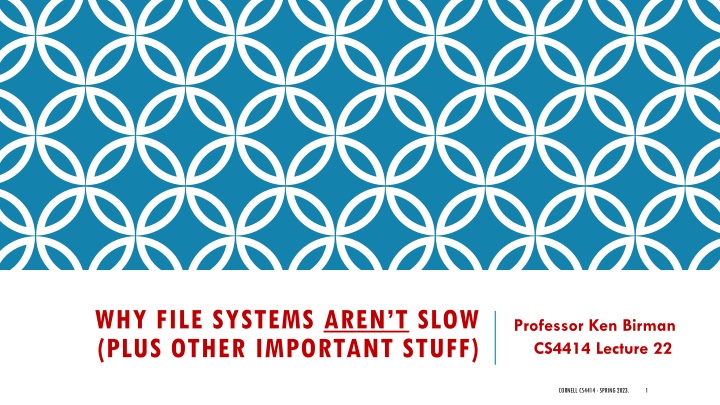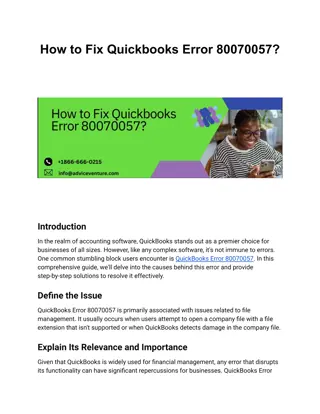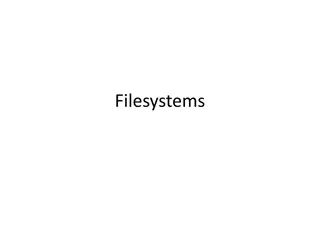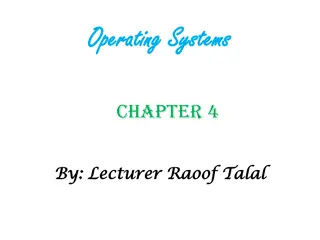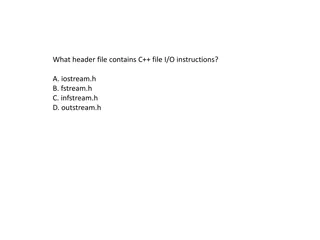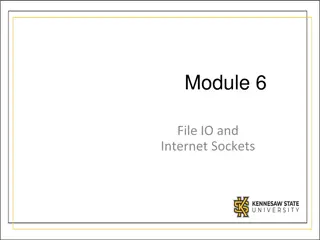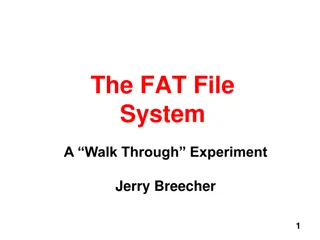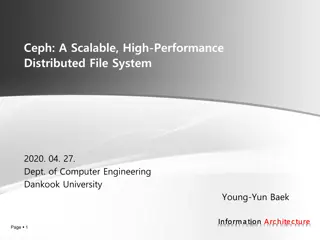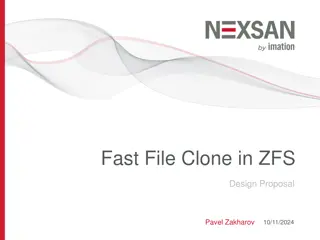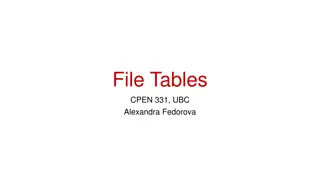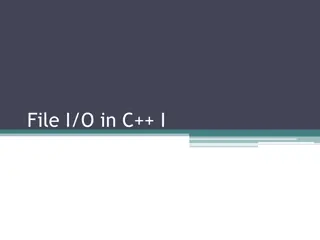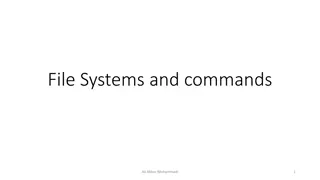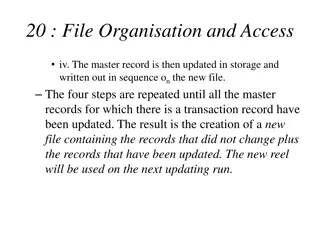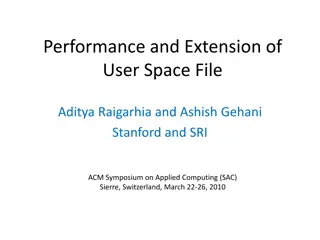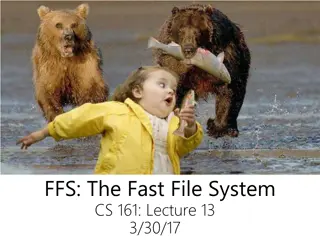Challenges in File System Performance
File systems face inherent high-latency challenges due to data fetching from storage units, leading to delays in accessing and transferring data. Despite fast data transfers, hardware communication with disks poses bottlenecks that impact performance and efficiency, requiring innovative solutions to mitigate delays and enhance overall system speed.
Download Presentation

Please find below an Image/Link to download the presentation.
The content on the website is provided AS IS for your information and personal use only. It may not be sold, licensed, or shared on other websites without obtaining consent from the author.If you encounter any issues during the download, it is possible that the publisher has removed the file from their server.
You are allowed to download the files provided on this website for personal or commercial use, subject to the condition that they are used lawfully. All files are the property of their respective owners.
The content on the website is provided AS IS for your information and personal use only. It may not be sold, licensed, or shared on other websites without obtaining consent from the author.
E N D
Presentation Transcript
WHY FILE SYSTEMS ARENT SLOW (PLUS OTHER IMPORTANT STUFF) Professor Ken Birman CS4414 Lecture 22 CORNELL CS4414 - SPRING 2023. 1
IDEA MAP FOR TODAY We have seen that file systems come in many shapes, sizes, and run in many places! Yet what file systems are doing is inherently high-latency: Fetching bytes from some random place on a storage unit that may be a rotating physical platter accessed by moving read heads. Caching and the working set Prefetching Secondary indices CORNELL CS4414 - SPRING 2023. 2
PERFORMANCE OF A FILE SYSTEM Application must open the file Linux will need to access the directory scan it to find the name and inode number load the inode into memory check access permissions So, opening a file could involve 2 or more disk reads (more if the directory is large). CORNELL CS4414 - SPRING 2023. 3
THE FUNDAMENTAL ISSUE? Data transfers are pretty fast They use a feature called direct memory access (DMA) DMA can match memory speeds, if the disk can send/receive data that rapidly (some devices can, many can t). But the delays for accessing storage are hard to eliminate. They come from the hardware required to talk to the disk (or network) CORNELL CS4414 - SPRING 2023. 4
THE FUNDAMENTAL ISSUE? To read data we pay (delay to talk to the disk) + (transfer time) Obviously, the code itself needs to be as efficient as possible, but we won t get rid of these hardware costs Can we find ways to hide this delay from the application? CORNELL CS4414 - SPRING 2023. 5
READING THE FILE The application might modify the seek pointer. This is free. Then does a read of some number of bytes File system must look up the block at this offset into the file Could involve scanning several levels of disk-block indices if file is big Once it has the block number, file system reads that block Once the block is in the buffer pool, kernel copies the data to user space, tells the process how many bytes were read (in case of EOF) could easily require 3 or 4 disk I/O operations to do all of this. CORNELL CS4414 - SPRING 2023. 6
EXAMPLE OF WORST-CASE PERFORMANCE Many people use print statements to debug programs, and redirect into a file if there will be a lot of lines of output. Each line is normally written as it is produced. Each write is just like a read: copy to the kernel plus (perhaps) many disk writes to update the inode, block list and the block, plus (perhaps) to remove a block from the free list. CORNELL CS4414 - SPRING 2023. 7
WHAT HAPPENS? This works, but will often cause slow motion behavior If you check, you ll find that all of these I/O requests are causing a huge bottleneck. This is why we use buffered I/O solutions. They save up 4K or 8K of bytes in a buffer, they write it all at once. CORNELL CS4414 - SPRING 2023. 8
COSTS OF A KERNEL READ OR WRITE The system call itself requires a trap, must save user context and switch into kernel context. The kernel may have been busy; if so, your request could easily block waiting for locks or for a thread to service it. We need to fetch the actual data, which might not be in the buffer pool. Memcpy from kernel to user, or user to kernel. CORNELL CS4414 - SPRING 2023. 9
COSTS OF A KERNEL READ OR WRITE The system call itself requires a trap, must save user context and switch into kernel context. All of this could easily require several milliseconds. Although a millisecond is a small amount of time, you may be limited to The kernel may have been busy; if so, your request could easily block waiting for locks or for a thread to service it. We need to fetch the actual data, which might not be in the buffer pool. several hundred such requests per second. Memcpy from kernel to user, or user to kernel. CORNELL CS4414 - SPRING 2023. 10
HOW IOSTREAMS DECIDES WHEN TO ISSUE A WRITE REQUEST The std::endl object has two roles It has a value , which is \n (the ASCII newline character) It also has a side-effect , which is to cause the line to be written Effect is that every line will trigger a write if you use std::endl. In contrast, with \n you still get line by line printouts, but the data will be buffered until the iostream buffer is filled. CORNELL CS4414 - SPRING 2023. 11
BUFFERED I/O IS MUCH FASTER, BUT Suppose your program happens to crash. What would happen to the last 1.5K of print messages? they could have been in the I/O stream buffer, in memory, and would not be printed! The file of debug output will be missing hundreds of lines of output! CORNELL CS4414 - SPRING 2023. 12
REMINDER: ZOOKEEPER We mentioned that Zookeeper itself is fault-tolerant, but has issues . It uses checkpoints: Periodically, it saves its state to disk. Zookeeper can have amnesia when it recovers from a shutdown. The most recent updates can be lost. Fundamental issue: If Zookeeper checkpoints every update, it runs too slowly, so they only do it every 5 seconds! CORNELL CS4414 - SPRING 2023. 13
SO WHY IS NORMAL FILE I/O SO FAST? WE SAW THIS IN LECTURE 2 (A QUICK REVIEW) Several factors come into play all at once 1. Linux retains blocks from the disk in the file system buffer pool and can respond to reads immediately if it gets a cache hit. 2. Linux uses a write-through policy: Writes update the block in the buffer pool. The program continues the actual disk I/O might be delayed for a while. 3. Linux anticipates likely future reads and prefetches data 4. Many modern disks have caches of their own. For these, a disk read can be satisfied instantly if the block is in the disk cache CORNELL CS4414 - SPRING 2023. 14
CACHING: THE CORE CHALLENGE IS TO HAVE THE WORKING SET IN THE CACHE We use this term in several situations. Linux sometimes does paging to reduce the pressure on memory. A process has the working set in memory if all the instructions and data it actually touches when running are resident. Similarly, the disk buffer pool holds the working set if it already has a copy of the files the application is likely to access. CORNELL CS4414 - SPRING 2023. 15
WHY WOULD THIS EVER HAPPEN? Modern workloads often involve running some program again and again with many inputs unchanged. For example, when training a vision system (a type of neural network called a CNN), we might reread the same input photos again and again while adjusting the CNN model parameters. CORNELL CS4414 - SPRING 2023. 16
COLD START (FIRST READ) VERSUS WARM The first time the files are accessed, Linux needs to read them. But then they linger in cache, so the second and subsequent reads get cache hits on the buffer pool. This is called a warm cache situation. CORNELL CS4414 - SPRING 2023. 17
CACHE EVICTION ALGORITHMS When a new block is loaded into a full cache, decides which to evict. One option is to use Least Recently Used (LRU) caching. Evict the block that has not been touched in the longest amount of time. Implementation: Keep a queue. As each block is touched, move it to the head of the queue. The LRU block is at the tail of the queue. CORNELL CS4414 - SPRING 2023. 18
CACHE EVICTION ALGORITHMS Issue with LRU: If we run a training system, as in the example, it may delay a long time before revisiting files. Those blocks will often be evicted just before we finally access them again. Causes a form of thrashing : wasteful pattern of evicting blocks, then reloading them. CORNELL CS4414 - SPRING 2023. 19
LEAST FREQUENTLY USED (LFU) With this algorithm, we track how often each block is accessed. Retain a block if it is accessed more frequently evict a block that has not been accessed as often. Issue: If the cache is full of heavily accessed files, but now we stop accessing them, they might never be evicted! CORNELL CS4414 - SPRING 2023. 20
LFU WITH AGING This is like LFU, but as time passes, older references count less. Implemented by periodically multiplying the count by, e.g., 9/10 Effect is a form of LFU focused on recent accesses. CORNELL CS4414 - SPRING 2023. 21
MULTILEVEL APPROACH Similar to one of the thread scheduling policies we saw early in the course. Partition the cache. Block migrates from partition to partition based on an access time or access frequency rule. Now we can use a different eviction policy in each partition. CORNELL CS4414 - SPRING 2023. 22
SECOND CHANCE CACHING With multilevel approaches, one issue is that the partition sizes might not be ideal. Suppose that a process would get 100% hits if 2/3rds of the cache is devoted to frequently accessed blocks. But we limit the process to 1/3 of the cache. We get a high miss rate. A second-chance cache addresses this. CORNELL CS4414 - SPRING 2023. 23
WHEN A BLOCK IS EVICTED, IT MOVES TO THE SECOND-CHANCE CACHE We also write it to disk at this point, if the block is dirty. The idea is that if we weren t really using the full size of one of the partitions, a cache-miss on the heavy-hitter partition might be followed by a cache-hit on the second-chance cache. CORNELL CS4414 - SPRING 2023. 24
MULTIPROCESS CONSIDERATIONS LRU and LFU are usually expressed in terms of a fixed-size cache. But we might prefer to allocate different amounts of cache space to different processes! How would we estimate how much each requires? CORNELL CS4414 - SPRING 2023. 25
WORKING SET TRACKING We use these methods when the amount of memory for each process might be varied some will get more, some less. Goal: Estimate the working set each process is accessing. Definition: The working set is the set of pages or files or blocks being accessed during some window of time. CORNELL CS4414 - SPRING 2023. 26
INSIGHT Most applications havelocality, meaning they loop and repeat the same things in time (temporal locality) and also access the same regions of memory for a while (spatial locality). If the resident memory includes all the pages of code that are running, all the data this code accesses, and all the file blocks being processed right now, the program runs without pausing. Having the working set in memory is necessary and sufficient. CORNELL CS4414 - SPRING 2023. 27
WORKING SET TRACKING We start by introducing a clock, and need to track reads/writes. The clock defines epochs, usually 100ms each. If a block is accessed, mark it as active. If a file (or a block of a file) hasn t been accessed in t epochs, evict it (but in fact, use a second-chance cache). t is tunable. CORNELL CS4414 - SPRING 2023. 28
WHAT IF THE KERNEL STILL WONT HAVE ENOUGH SPACE? If we are still short on space, we might evict a block some process is going to need. But at this point, we know that this process would not run if we schedule it. We could actually evict its entire working set. Later, when resuming it, we could pull its whole working set back in! This is a strategy called swapping . CORNELL CS4414 - SPRING 2023. 29
WHICH POLICIES ARE FOUND IN LINUX? The answer turns out to vary depending on which Linux. Moreover, some allow power users to tune these policies. Even so, this set of methods is part of an engineering design pattern. Even without a std::xxx class supporting this pattern, we often use these ideas when designing big systems! CORNELL CS4414 - SPRING 2023. 30
PREFETCHING IS ALSO A POWERFUL TOOL When Linux sees that you have read two or more blocks in a row, it prefetches the next blocks. Goal is to have a steady overlap of file access with reading. This is hugely valuable on networks, which often have very high bandwidth but relatively high delays. CORNELL CS4414 - SPRING 2023. 31
SECONDARY INDICES Systems often use some form of sort to access data. But it may not be the primary sort, which is based on the primary keys. If the same sort is used often, we precompute a secondary index . We can use this to initiate prefetching. Linux has an asynchronous I/O option that can start a read in advance of when data will be needed. CORNELL CS4414 - SPRING 2023. 32
LINUX ASYNCHRONOUS FILE READS POSIX API for the file system: AIO When you compile, must include the aio.h header and also provide C++ with a flag, -rt. This flag appears at the end of the command line. It is actually being passed to the linker, not the compiler. CORNELL CS4414 - SPRING 2023. 33
POSIX AIO OPERATIONS: KERNEL API aio_read like read, but returns an aio id aio_write like write, but returns an aio id aio_fsync asynchronously requests that data be flushed to disk aio_error error number returned by a failed aio request aio_return obtain the outcome (returned result) for a request aio_suspend wait for specified request(s) to complete aio_cancel cancel specified requests lio_listio enqueue a list of operations rather than just one CORNELL CS4414 - SPRING 2023. 34
MICROSOFT ASYNCHRONOUS I/O CLASS Called System.IO Has a native implementation for the Windows kernel, which supports Linux, but can also be accessed directly from C++ Portable (open source) but not widely used in C++ programs. CORNELL CS4414 - SPRING 2023. 35
A PUZZLE ABOUT FAST-WC Think back to our fast word-count program from Lecture 1 and 2 It had a thread to open files, which is good fast-wc has many files to open! But then it just used Linux file I/O (POSIX read) into a character array: read, then scan. Read, then scan. Etc. CORNELL CS4414 - SPRING 2023. 36
A PUZZLE ABOUT FAST-WC Suppose that we instead mapped entire files with mmap? Or used AIO: We could start the read on block k+1 as we scan block k. Which would be faster? CORNELL CS4414 - SPRING 2023. 37
IT ISNT OBVIOUS! With mapped files, we eliminate the memcpy from the kernel to user space that occurs with read. With mmap, the file is directly in user space (blocks from the buffer pool are mapped into the user memory) But memcpy runs at 18GB/second on compute30, and the whole Linux source files, in total, were only 836MB. So copying takes a total of just 0.64s. Saving this amount of time won t help much. Suggests that mmap won t be a big win for fast-wc CORNELL CS4414 - SPRING 2023. 38
WHAT ABOUT ASYNCHRONOUS I/O Ken tried it! It has no measurable impact What does this tell us? CORNELL CS4414 - SPRING 2023. 39
WHAT ABOUT ASYNCHRONOUS I/O If asynchronous file reads don t help, this must mean that the Ken tried it! It has no measurable impact application isn t pausing waiting for file reads to complete. We know that memcpy, in total, is just 0.64s and this cost is What does this tell us? spread over all 24 cores, so any single core waits roughly 0.026s. Conclusion? Linux prefetching must be working well enough to fetch the next block before we request it, so that read() doesn t really wait. CORNELL CS4414 - SPRING 2023. 40
WHEN DOES ASYNCHRONOUS I/O HELP? Imagine a program with a very random looking data access pattern, like a particle physics program doing analysis from detector data. Detectors produce gigabytes of data per event huge files The application focuses on the data showing actual tracks Linux won t anticipate this pattern of access, so asynchronous I/O could really help a lot. It offers a way to tell Linux what to prefetch . CORNELL CS4414 - SPRING 2023. 41
SELECT Orders.OrderID, Customers.CustomerName, FROM Orders where Orders.CustomerID=Customers.CustomerID; DATABASE EXAMPLE A query such as this is fastest if both Orders and Customers are sorted by CustomerID. Many systems use big databases. These manage data in relations, which are sorted tables. Each row has a primary key, and this is used for sorting. But perhaps some query accesses the data using a different key. CORNELL CS4414 - SPRING 2023. 42
SELECT Orders.OrderID, Customers.CustomerName, FROM Orders where Orders.CustomerID=Customers.CustomerID; DATABASE EXAMPLE If Orders is sorted by OrderID and Customers by LastName, a secondary index for each will help. Here, the database will construct a fast search index: a data structure that tells it which row to access next (or even, which block in the file holding the data). Using asynchronous I/O, the database can execute the query on the current block while having Linux prefetch the next blocks it will need to scan. CORNELL CS4414 - SPRING 2023. 43
WHOLE-FILE PREFETCHING With a network file system, it often makes sense to fetch the entire file the first time it is used. In some systems, a prediction is even made before the file is opened and it is prefetched in anticipation. This does use network resources, but hides the delays if the guess was valid! CORNELL CS4414 - SPRING 2023. 44
WORKING SETS AT THE FILE LEVEL These forms of file prefetching lead to the idea that groups of files are often accessed together. The file system can potentially learn the group and fetch them all if any one is accessed. In fact, you could imagine a helper file for each file: if anyone accesses me, they will probably access xxx, yyy, and zzz too CORNELL CS4414 - SPRING 2023. 45
PRELOADING DLLS An important case is when a process will use a collection of DLLs. If Linux can anticipate which will be needed, it can load them all at once when the process is launched. Many DLLs tend to all be used together, not in isolation. Linux has a preload daemon for this specific case! CORNELL CS4414 - SPRING 2023. 46
FILE COMPRESSION IDEAS File systems store files in blocks of fixed size But do applications really access files block by block? Some file systems have explored a mix of compression (which simply squeezes the file down) with variable sized blocks, aimed at transferring the entire useful portion of the file CORNELL CS4414 - SPRING 2023. 47
ANTICIPATORY FILE CACHING IN THE NETWORK Because more and more users are mobile, ISPs are thinking about how to improve performance and reduce load on the ISP network by caching videos and photos. In these systems, as you move from place to place, they transfer your cache and prefetch data to the access point your device is associated with. This masks big last-moment delays! CORNELL CS4414 - SPRING 2023. 48
IF ONE COPY IS GOOD WHY NOT MORE? Suppose that a storage system has huge capacity and is only partly in use. Why not use this space in some way that could improve performance? Systems based on this idea make extra copies just in case they might be used later. CORNELL CS4414 - SPRING 2023. 49
PREDICTING POPULARITY Facebook is an example of a company that uses machine learning to decide What to cache (and where to cache it) When to prefetch files (photos or videos) Which files may become viral Which files have gone cold and can be evicted CORNELL CS4414 - SPRING 2023. 50
